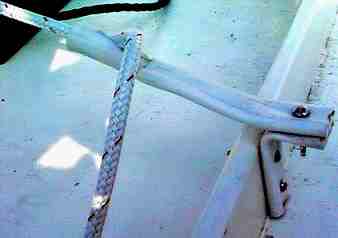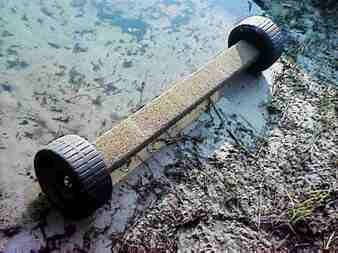Cleat & Stuff... |
NEW!
A main sheet contraption A simple Jam Seat Cleat Simple boat dolly |
I love discovering or inventing ways to achieve elegant results with simple low tech materials. Craig O'donnel is a genius at this. See his "Cheap Pages."
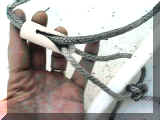 Here are some cleats I've come up with made from plastic tubing. These are very
"quick and dirty." I made the first three pictured in about an hour.
The material cost is negligible. This ivory colored plastic pipe, (I
believe it's called CPVC) is available in different diameters. The
brand name on it is Coastline. The ones in the pictures are 5/8" I.D. and
about 7/8" O.D. Make sure you sand all edges pretty smooth to prevent line
chafe. These are my first experiments so I don't know about UV resistance or
longevity. I'll keep you posted.
Here are some cleats I've come up with made from plastic tubing. These are very
"quick and dirty." I made the first three pictured in about an hour.
The material cost is negligible. This ivory colored plastic pipe, (I
believe it's called CPVC) is available in different diameters. The
brand name on it is Coastline. The ones in the pictures are 5/8" I.D. and
about 7/8" O.D. Make sure you sand all edges pretty smooth to prevent line
chafe. These are my first experiments so I don't know about UV resistance or
longevity. I'll keep you posted.
My NEW fancier main sheet contraption at the bottom is in ordinary 3/4" PVC. Since I was told it would bend at lower temperatures.
The first one above takes the place of a fair lead and cam cleats on a small boat. I have mine tied to the middle of the central frame with 3/16" line. It's not as foolproof as "the real thing" but is far better than just hanging onto the main sheet, or wrapping it around a normal cleat.
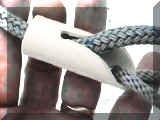 Here's a close up of it. It's cut at a 45 degree angle. A 3/16" hole is
drilled in the side. Sketch out then cut a tapered V to this hole. Drill the
mounting hole the size you need for your mounting cord. (mine is 1/4") With
practice you can adjust it with one hand. A downward sqeeeze with the thumb will
release it. Works well in combination with a tiller tamer of some sort. (A
simple one of these soon!)
Here's a close up of it. It's cut at a 45 degree angle. A 3/16" hole is
drilled in the side. Sketch out then cut a tapered V to this hole. Drill the
mounting hole the size you need for your mounting cord. (mine is 1/4") With
practice you can adjust it with one hand. A downward sqeeeze with the thumb will
release it. Works well in combination with a tiller tamer of some sort. (A
simple one of these soon!)
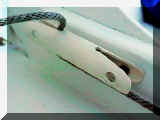 This one is similar to a horn cleat or jam cleat, being a bit of both. Again,
the slot holes are 3/16" as are the mounting holes. They are drilled all
the way through, then the upper holes are enlarged to 5/16" to allow
clearance for the screw head and driver for mounting.
This one is similar to a horn cleat or jam cleat, being a bit of both. Again,
the slot holes are 3/16" as are the mounting holes. They are drilled all
the way through, then the upper holes are enlarged to 5/16" to allow
clearance for the screw head and driver for mounting.
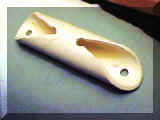 This last one is pretty experimental. It's designed to take a line or bungee
cord running through it that can then be prevented from running out either way.
Not often necessary, but handy for things like the loop of line used on my
Venture McGreggor's rudder to both hold the rudder up and down.
This last one is pretty experimental. It's designed to take a line or bungee
cord running through it that can then be prevented from running out either way.
Not often necessary, but handy for things like the loop of line used on my
Venture McGreggor's rudder to both hold the rudder up and down.
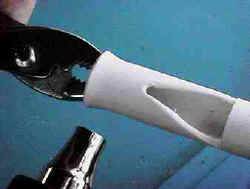 |
Heat and pliers create a nice flare to allow the line to feed in smoothly. I matched the angle to the line that feed into it from the bridal over my transom. | 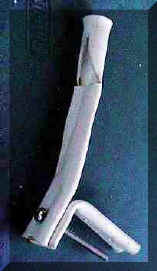 |
Experiment with different sized tubing and slots for the line you're using. Let me know your results! simplicityboats
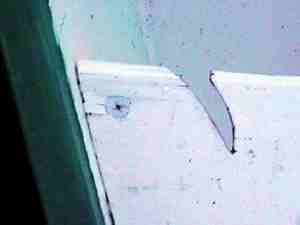 This is a simple notch cut in the
mast step/ seat with a saber saw. I have one on either end. The halyard
and down haul go through 1/2" holes at the base of the mast, then
come under seat and up into jam slot. Works great with no hardware! For
slippery line take a turn around the seat before jamming.
This is a simple notch cut in the
mast step/ seat with a saber saw. I have one on either end. The halyard
and down haul go through 1/2" holes at the base of the mast, then
come under seat and up into jam slot. Works great with no hardware! For
slippery line take a turn around the seat before jamming.
